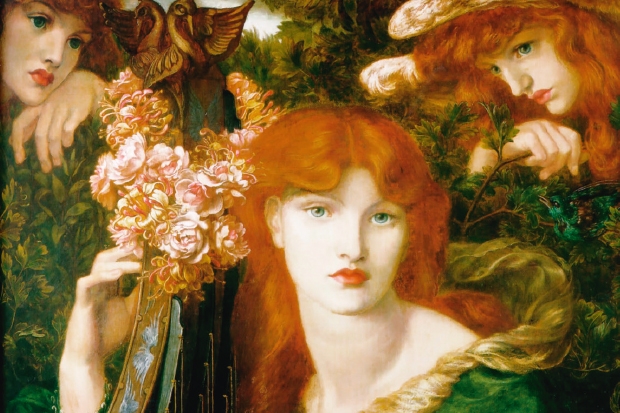‘Gentlemen prefer blondes,’ Anita Loos pronounced, ‘but gentlemen marry brunettes.’ Quite what they do with redheads she never revealed (and I’ve often wondered), but with Red: A Natural History of the Redhead, Jacky Colliss Harvey sets out to discover everything — what it takes to make a redhead, where in the world they come from and why they exist at all; whether redheads are actually different or just treated differently; how they got their reputation, what that reputation might be and whether they deserve it.
The history begins some 40,000 years ago, we are told, when the gene for red hair was carried from ‘the grasslands of Central Asia’ to Europe. We encounter the bones of red-headed Neanderthals in a Spanish cave, red-headed Thracians depicted in ancient Greek art, a red-haired Boudicca, red-headed Scythians, vilified red-haired Jews in medieval Europe and so on across the centuries until redheads are pocketed at their highest density (of 13 per cent, compared with fewer than one per cent worldwide) in Scotland, Ireland, Wales and the Udmurt Republic (at the top of the Volga). This is a history of migration, the author contends, until it reaches these corners ‘set apart from the great ebb and flow of the human ocean’ and the ‘liminal populations’ in those regions. At this point the ‘fixing of red hair among these liminal populations’ becomes ‘a phenomenon that exists logically and obviously’ — i.e. a numbers game.
A redhead herself, and feeling her character defined by that accident of genetics, Colliss Harvey’s project is personal: she is investigating a tribe of which she is a member. When she traces the history of redheads and catalogues the redheads of history, art, literature, cinema and fairytale, she communicates to her reader a feeling of intense solidarity with her subject. She is not just a person with red hair, she is ‘a redhead’, and being a redhead, she says, ‘is the single most significant characteristic of my life’.

As a result of this attachment Red is a memoir as well as a study. But that doesn’t make it uninteresting; only a little bit fulsome — a paean to its subject. Colliss Harvey found ‘growing up as a redhead’ to be ‘deeply confusing’, not least because everyone had something to say about her hair (and some even wanted to touch it). ‘It sometimes felt,’ she says, ‘as if the last person my red hair belonged to was me.’ Now, however, she is reconciled to her specialness: in the last chapter she travels to the Netherlands to address a gathering of redheads at a festival called ‘Redhead Days’, and when someone asks, ‘Where do redheads feel they belong?’ her answer is, ‘Right here.’
There is much about being redheaded of which I was ignorant. I had no idea, for example, that ‘any scent or cologne will smell different on a redhead’; that a redhead’s ‘unique biochemistry’ means she or he will ‘feel more pain than blondes or brunettes’ (and apparently require 20 per cent more anaesthesia to be knocked out) or that ‘redheads are also much more likely to be stung by bees’. I did not know that ‘red hair has been indispensable to the image of the indomitable, ferocious and usually voluptuous female barbarian’; nor that ‘in medieval art red hair in men… [is] visual shorthand for a brutal character’.
This is, for me, the most interesting aspect of the subject: not red hair per se or the experience of redheadedness but the meaning we have ascribed to ‘the redhead’ (as we have conjured up a persona for ‘the blonde’) over the centuries. Mary Magdalene: the original flame-haired temptress. Judas Iscariot: the original red-haired villain. In cinema, as in art, red hair is used as a signal: you have been warned. Jessica Rabbit — red hair, red lips, red dress — protests, ‘I’m not bad. I’m just drawn that way.’ (‘Coloured in that way’ is what she means.) Thelma and Louise are both redheads. Both! So what can you expect? No less than a pair of trigger-happy, insubordinate runaways whose hair gets bigger, wilder and redder as the film goes on. This is hair colour worn as a label: blonde, brunette and redhead are not descriptive terms so much as categories into which personalities are expected to fall. And if I sound like a typical feisty redhead, well, that’s because I am one.






Comments